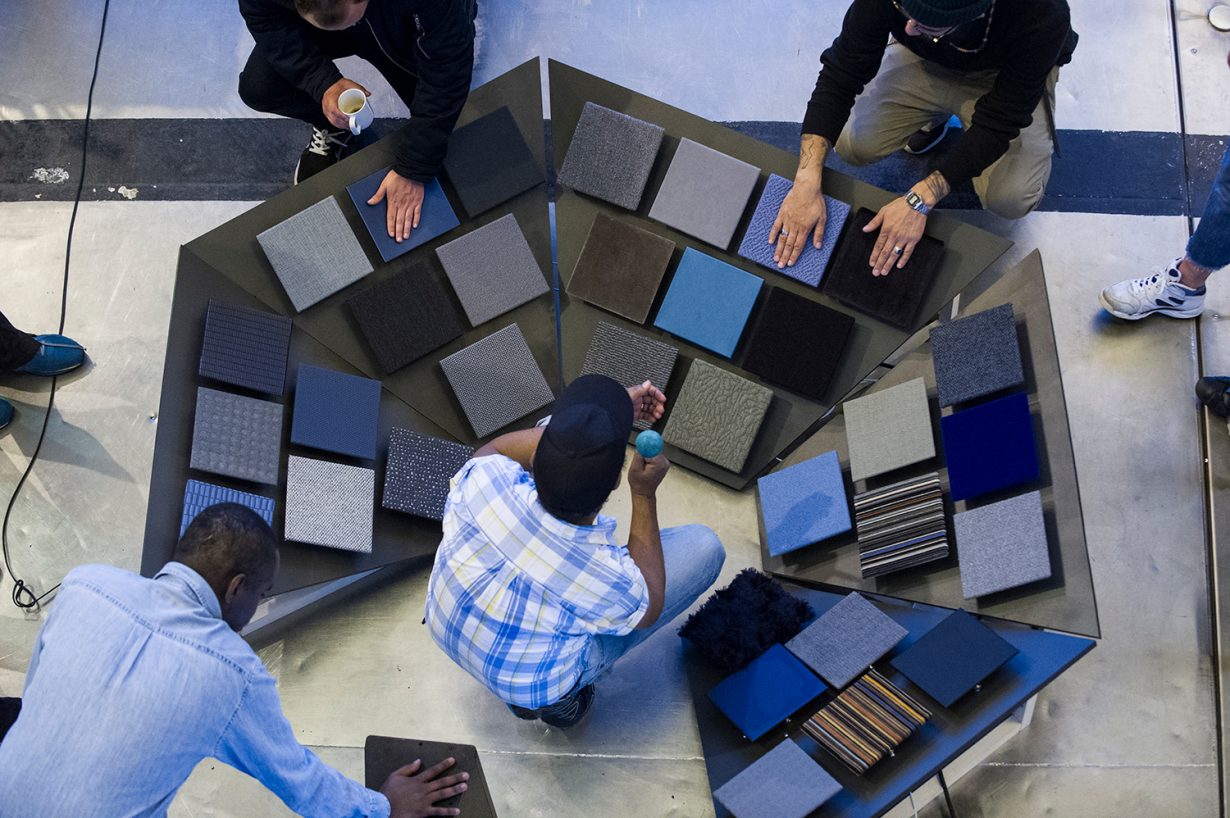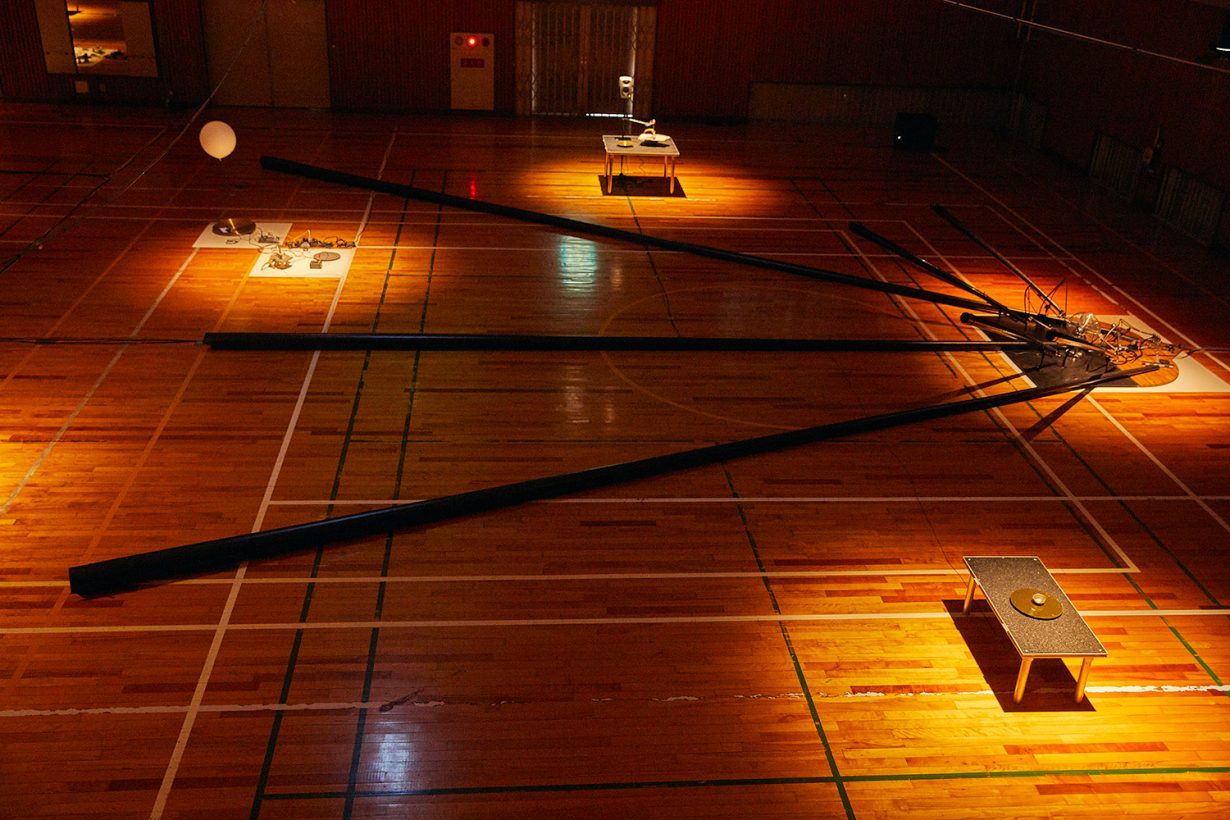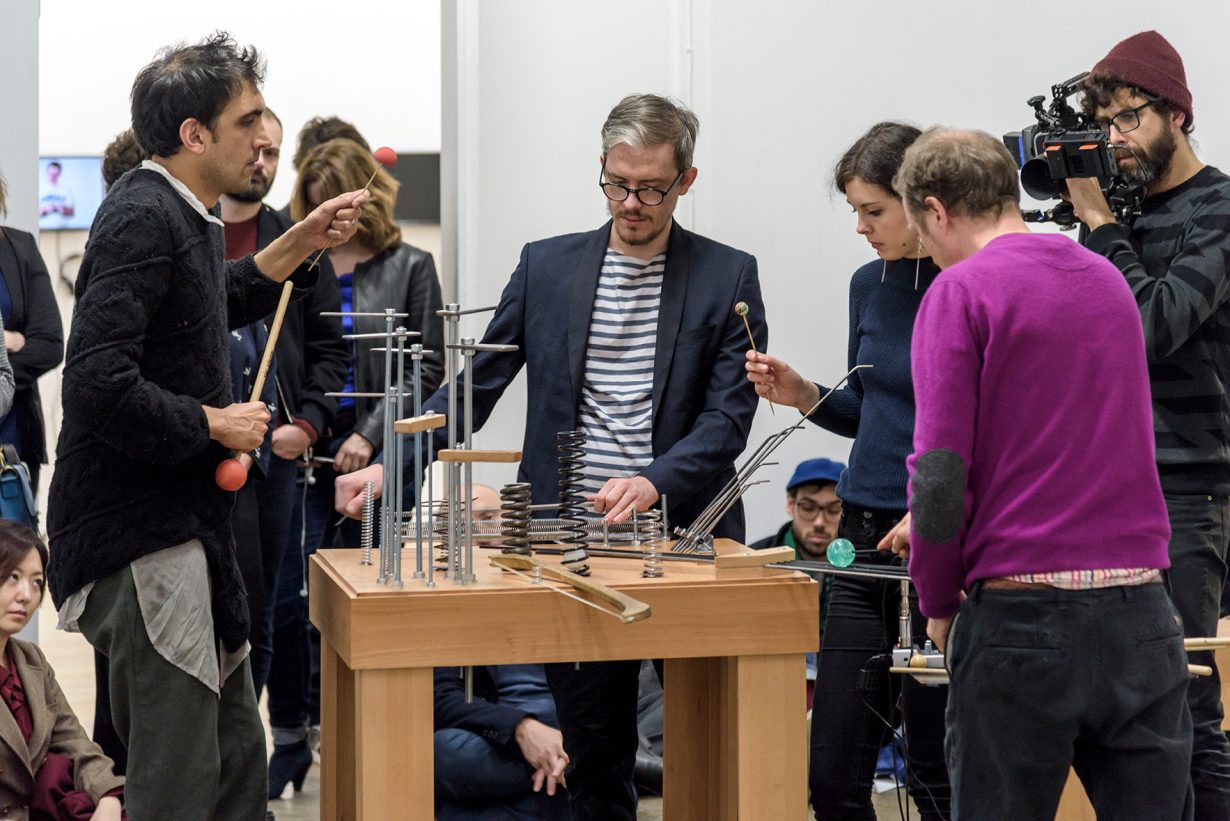The Beirut-born musician and artist’s instruments are objects of sculptural beauty, activated through touch and breath and motors – the sound of his performances resists conventional musicality
Every so often, a composer, seeking total musical freedom, breaks down the materials of music itself. So they build their own instruments, from scratch. Exponents have included Harry Partch, Daphne Oram, Pat Metheny, Björk and the Boredoms, to name a few. Tarek Atoui is a visual artist working on the outskirts of this rarefied group of innovators. He has built a knot of glass tubes into which he blows across pools of water to vary the pitch. He plays a turntable covered in sand with an animal horn and a bundle of herbs. His instruments are objects of sculptural beauty, activated through touch and breath and motors.
For the Beirut-born Atoui, though, these instruments are only one element of a controlled situation of organised sound – others include place and history, which he researches through travel, and the curating of his performers, who are often non-musicians. His ongoing piece WITHIN (2012–), for example, is an improvised performance by deaf people, who play instruments designed to emphasise the haptic qualities of musicianship, rather than aural ones.
The sound of Atoui’s performances is richly textural, and often resists conventional musicality. His 2019 exhibition The Wave, at Okayama Art Summit, was a collection of many of his instruments playing automatically, and together they produced a metallic flutter of clicks, teeming with skittering creatures. Other works approach abrasive noise, free improvisation and drone. When performing, Atoui often appears to be lost in an emotional trance, twisting his face like a blues guitarist as he taps a stone with a mallet or explores a knob on a wooden box.
Atoui and I spoke in the autumn of 2021. He and I discussed his innovative methods of listening to music and the challenges of being a musician in the ecosystem of contemporary art.

Ross Simonini Did you begin as a musician or as a visual artist?
Tarek Atoui The starting point was a musical one. Even today, I consider myself to be always doing composition.
RS But you don’t release much music in the form of albums.
TA I have released very few things. Bits and pieces of things here and there, besides a record release in 2006. And this characterises a bit like my situation and who I am and what I do.
RS You’ve mentioned John Cage as an important early influence. How did you start with music?
TA My interest in music came at eighteen with electronic music, new music, experimental music and noise music. This led me to electroacoustic music and the work of composers such as [Karlheinz] Stockhausen and Cage and many of his peers and colleagues of that time. At the same I was discovering improvised music.
RS Do you still consider your music to be electronic?
TA Yes, totally. And when I also say it’s all composition, this is one aspect of what I mean. What I do today is, I still use the computer and the ideas of sequencing and managing time and events, but instead of being applied inside an abstract piece of software on the computer, now it’s a motor, or a sculpture.
RS When you’re making instruments, what is your starting point?
TA At this point, it tends to start more and more from the organic materials themselves, and from thinking of ways of extracting sound or broadcasting sound through these materials. And then the electronics come at play when needed, by exploring the properties of materials and their acoustics, resonances and acoustic behaviours.

RS Working in this way, have you come to any sort of perennial truths about the relationship between visuals and sounds? I’m thinking for example of the Bouba/kiki effect, and how people around the world have similar visual associations for the words ‘Kiki’ and ‘Bouba’.
TA No, not really, but something I’m now deeply convinced of is the capacity of our brains to structure and make sense of how we receive and interact with sound. You see, whether we are a trained listener or somebody who listens to abstract noise music, we are both capable of listening in the same way. And that’s a nice starting point for me to create listening conditions.
RS What kind of conditions?
TA Like the condition of proximity, of being able to be close to the source of sound, to witness the mechanism. To see the process of sound happening. Like a piece of ceramic being struck by a bouncing wooden marble. Or two branches rubbing against a rough metallic surface which is amplified with contact microphones.
RS Is this why you don’t release much audio on its own, because you want the sound and visuals to be married?
TA Exactly. It’s not just about making it into a record and like having people be able to experience it in stereo. I want sound to be objectified in a certain way, in a certain sense, or offering people a different duration – where you can spend hours listening to something, not just like 20 minutes.
RS Do you enjoy recorded music?
TA I also like the abstraction of the source of the sound. I like field recordings, I like found footage. I like listening without knowing where it came from. But I have to also question the space in which I am listening to the sound system, and the sound terminal through which I am listening.
RS Right. It’s like laptop speakers – we consider them low quality now, but in 50 years we’ll remember that sound nostalgically.
TA Yes. But what is poor quality and what is good quality? That’s relative, in a certain way. Should all sounds have the same qualities? As a composer, it’s very nice to be able to navigate between ultracompressed, ultramodern, powerful sound and the old, degraded sound of the wax cylinder, one of the earliest forms of sound recording. I find it great to have cheap speakers along with supergood speakers. This palette is supergood.

RS Each speaker is its own kind of instrument.
TA They’re really identities. You can sometimes buy cheap amplifiers that are very loud and harsh and barky, and sometimes those are amazing.
RS How do you listen to other people’s music?
TA I have a situation now – I have been listening to all the records that my musician friends gave me after their gigs during the last five years. I have 60 records and I’m listening to these with a turntable plugged into a transducer connected to a metal bucket in which water is dripping. This is the left channel. And the right channel is sending the sound to an underwater speaker inside a glass box.
RS How does it sound?
TA Inside the glass is very resonant. Sound underwater travels superfast. So it bounces very harshly and quickly against the glass. You are in a very strange acoustic space when you listen through something like this.
RS Do you also listen to music casually, through your earbuds and a phone?
TA Yes.
RS So you’re not resistant to that kind of listening?
TA No, on the contrary, I find it fun. I just also find it fun listening inside the water tank. If you don’t like what you’re listening to, or you want to play with it, you can just add more water or subtract some, or you can blow bubbles into the water. You can play with disturbing this aquatic environment, and it makes listening playful.
RS How do you start making instruments?
TA I came into instrument-making from a digital space, from doing computer programming, then I shifted this knowledge to circuit boards and DIY electronics. That’s how I started building my first instrument, and then I started working with other people who do other types of instruments, whether strings or wind. So I went backwards, in way.
RS With your own instruments, you’re always a novice. You’re not dedicating 30 years to mastering the harp, for instance.
TA Yes, you see, this approach has its limits. So it’s not that type of mastery. I think I would like to master a more general way of listening. This is as important as learning one instrument.

RS Do you consider tuning systems when you’re making instruments?
TA Sometimes, but that’s where I regret not having studied music earlier. I tried to study solfège and musical notation and acoustic instruments, like the clarinet, but I realised it’s going to be a lot of work. So I studied electroacoustic music and programming and film recording, and sound editing. And I knew that this kind of production is an instrument that I could learn better with focus. I think now we have enough tools and history behind us to be able to consider traditional musicianship as an additional quality a musician has, but it’s not the only, fundamental quality anymore. I think people should not be so concerned about this. This is not what makes great musicians.
RS As someone working with improvisation, do you find that you’re searching for a certain feeling when you’re making your music?
TA Yes, when a unity happens between the body, the sound and the instrument. When everything seems to be in conversation with the space and with the people. But what you learn with time is not to force this feeling, and not to think that it comes from any situation where you’re in full confidence.
RS Have you found that working within contemporary art contexts changes the nature of musical performance?
TA It allows me to go to different places. It has put me in situations that were uncomfortable and difficult, but at the same time liberating. It invited me to rethink the way I was building my machines and responding to different contexts that the artworld offered, like working outdoors, or in museums where the acoustics would not be perfect or where people’s attention was not like a concert situation. And of course, someone’s first reaction could be to say, OK, this is not a good way to perform, and actually yes, it is not a good place to transpose the musical discourse, but there is definitely something you can do with it and things you can learn from it.
RS Art seems not to have decided on a correct set of parameters and musical systems in the way that the music world has.
TA Yeah. But there are parts of the world where it’s the same institutions doing the music and the arts, and there is not much cultural diversity. But I like these situations – where the musicians, artists and filmmakers are all in dialogue with each other.

RS Can you discuss any particular art context for performing?
TA In 2009 I was commissioned to do a performance in Sharjah, in the United Arab Emirates. It was supposed be in a closed courtyard, and there were so many people outside, unable to get in. But at the last minute it didn’t feel right. Why would it be in a courtyard, in a closed space, where you could still hear the music from outside? And so we decided to play outside. And then it became for me a very nice, memorable moment. The audience mixed and merged with people in the street and it felt like a real opening was happening in the city.
RS We think of music as isolated artform, to be watched and heard in a concert hall, but traditionally it was woven into ritual and ceremony and daily life.
TA Yes. I did a performance at the Berkeley Art Museum in 2015, and for this we put nine huge Meyer Sound subwoofers inside the building. These were very resonant in the building. People could view the performance from different levels in different floors. It lasted an hour and a half, but it was nice to see that people were not even looking at the performers. They could listen to these very low-end vibrations through the wood, through the materials of the architecture. At that moment, the building and these different people all came together at once.
RS Do you test the acoustics in buildings where you work?
TA No. To test and predict the behaviour of nine subwoofers inside a four-storey nineteenth-century building requires a large budget.
RS You seem to have a more punk approach to the situation.
TA Yeah, it feels right. For me, I’m always considering where to spend effort and where not to spend effort. I don’t want to worry about a lot about calculations and validating them.
RS Do you think you’re moving towards the Cagean philosophy in which all sound is music?
TA Well, no. Of course, all sound can be music, depending on how you want to use it and work with it. But sound can be so many things. It can be a source of energy. It can be a source of emotion to be manipulated. It can be other things besides being music, and it’s nice to be manipulated.
The Whisperers, a solo exhibition by Tarek Atoui, is on view at Chantal Crousel, Paris, through 20 November.
Ross Simonini is a writer, artist, musician and dialogist. He is the host of ArtReview’s podcast Subject, Object, Verb
